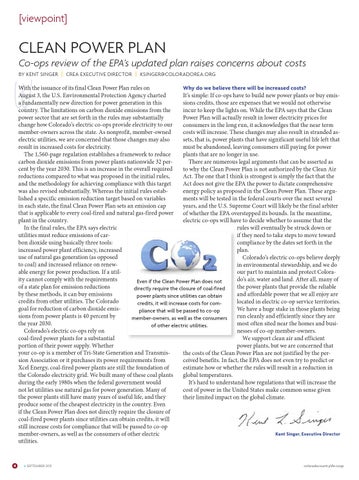[viewpoint]
CLEAN POWER PLAN
Co-ops review of the EPA’s updated plan raises concerns about costs
W
BY KENT SINGER || CREA EXECUTIVE DIRECTOR || KSINGER@COLORADOREA.ORG
With the issuance of its final Clean Power Plan rules on Why do we believe there will be increased costs? August 3, the U.S. Environmental Protection Agency charted It’s simple: If co-ops have to build new power plants or buy emisa fundamentally new direction for power generation in this sions credits, those are expenses that we would not otherwise country. The limitations on carbon dioxide emissions from the incur to keep the lights on. While the EPA says that the Clean power sector that are set forth in the rules may substantially Power Plan will actually result in lower electricity prices for change how Colorado’s electric co-ops provide electricity to our consumers in the long run, it acknowledges that the near term member-owners across the state. As nonprofit, member-owned costs will increase. These changes may also result in stranded aselectric utilities, we are concerned that those changes may also sets, that is, power plants that have significant useful life left that result in increased costs for electricity. must be abandoned, leaving consumers still paying for power The 1,560-page regulation establishes a framework to reduce plants that are no longer in use. carbon dioxide emissions from power plants nationwide 32 perThere are numerous legal arguments that can be asserted as cent by the year 2030. This is an increase in the overall required to why the Clean Power Plan is not authorized by the Clean Air reductions compared to what was proposed in the initial rules, Act. The one that I think is strongest is simply the fact that the and the methodology for achieving compliance with this target Act does not give the EPA the power to dictate comprehensive was also revised substantially. Whereas the initial rules estabenergy policy as proposed in the Clean Power Plan. These argulished a specific emission reduction target based on variables ments will be tested in the federal courts over the next several in each state, the final Clean Power Plan sets an emission cap years, and the U.S. Supreme Court will likely be the final arbiter that is applicable to every coal-fired and natural gas-fired power of whether the EPA overstepped its bounds. In the meantime, plant in the country. electric co-ops will have to decide whether to assume that the In the final rules, the EPA says electric rules will eventually be struck down or utilities must reduce emissions of carif they need to take steps to move toward bon dioxide using basically three tools: compliance by the dates set forth in the increased power plant efficiency, increased plan. use of natural gas generation (as opposed Colorado’s electric co-ops believe deeply to coal) and increased reliance on renewin environmental stewardship, and we do able energy for power production. If a utilour part to maintain and protect Coloraity cannot comply with the requirements do’s air, water and land. After all, many of Even if the Clean Power Plan does not of a state plan for emission reductions the power plants that provide the reliable directly require the closure of coal-fired by these methods, it can buy emissions and affordable power that we all enjoy are power plants since utilities can obtain credits from other utilities. The Colorado located in electric co-op service territories. credits, it will increase costs for comgoal for reduction of carbon dioxide emisWe have a huge stake in those plants being pliance that will be passed to co-op sions from power plants is 40 percent by run cleanly and efficiently since they are member-owners, as well as the consumers the year 2030. most often sited near the homes and busiof other electric utilities. Colorado’s electric co-ops rely on nesses of co-op member-owners. coal-fired power plants for a substantial We support clean air and efficient portion of their power supply. Whether power plants, but we are concerned that your co-op is a member of Tri-State Generation and Transmisthe costs of the Clean Power Plan are not justified by the persion Association or it purchases its power requirements from ceived benefits. In fact, the EPA does not even try to predict or Xcel Energy, coal-fired power plants are still the foundation of estimate how or whether the rules will result in a reduction in the Colorado electricity grid. We built many of these coal plants global temperatures. during the early 1980s when the federal government would It’s hard to understand how regulations that will increase the not let utilities use natural gas for power generation. Many of cost of power in the United States make common sense given the power plants still have many years of useful life, and they their limited impact on the global climate. produce some of the cheapest electricity in the country. Even if the Clean Power Plan does not directly require the closure of coal-fired power plants since utilities can obtain credits, it will still increase costs for compliance that will be passed to co-op Kent Singer, Executive Director member-owners, as well as the consumers of other electric utilities.
4
4
SEPTEMBER 2015
coloradocountrylife.coop
